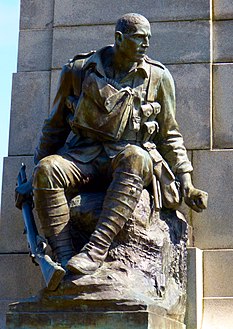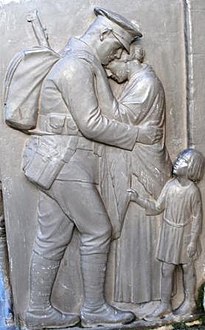Walter Marsden
Walter Marsden | |
|---|---|
 Part of the Bolton War Memorial-Peace restraining war. | |
| Born | 1883 Church, Lancashire, England |
| Died | 1969 |
| Nationality | English |
| Education | Accrington Technical School, Manchester Municipal College of Art, Royal College of Art |
| Known for | Sculpture |
| Notable work | Sculpture, war memorials (mainly in Lancashire) |
Walter Marsden MC (1882–1969) was an English sculptor born in Lancashire. He saw active service in the First World War and was awarded the Military Cross and Bar. He was awarded a civil pension by Queen Elizabeth 2 for services to sculpure. He was an associate of the Royal college of Art. He served in the Home Guard during WW 2 and worked for the Ministry of Home Security Camouflage Unit. Marsden assisted with the restoration work following the bombing of Coventry Cathedral.
After the war, like many other sculptors who were also ex-servicemen, he carried out sculptural work on war memorials. All but two of these were erected in Lancashire.
Marsden also spoke at speaking engagements about a wide variety of art-related topics. In 1944 he became an instructor at Saint Martin's School of Art and continued teaching until about 1952.
Personal and career life
[edit]Walter Marsden, the son of a blacksmith, was born in Church near Accrington in Lancashire, England in 1882.[1]
Starting in 1901 he was an apprentice at the Accrington Brick and Tile Company, whose owners, the McAlpine family, recognised his talent, and encouraged him to study at the Accrington Technical School. From there, Marsden secured a place at the Manchester Municipal College of Art in about 1908. In the 1911 census he gave his occupation as a "clay modeller".[1]
He served as an officer in the Loyal North Lancashire Regiment and was awarded a Military Cross[2] fighting in the Third Battle of Ypres in 1917. He was later taken prisoner at Cambrai, France, and sent to a prisoner of war camp.[3]
After the war he returned to his studies and attended the Royal College of Art between 1919 and 1920 where Édouard Lantéri was one of his instructors.[1]
From 1930 until 1941, when he resigned, Marsden was a member of the Art Workers Guild. From 1930 to 1941 he was a member of the council of the Royal Society of British Sculptors; He became a Fellow of the Society in 1938 and remained so until 1956. Marsden was a Saint Martin's School of Art temporary instructor starting in 1944. He taught modelling. He was a full-time instructor from 1948 to 1952, his work including teaching sculpture.[1]
Marsden died in August 1969.[1]
Works
[edit]Notable work
[edit]St Annes on Sea War Memorial
[edit]Marsden carried out the sculptural work for the war memorial at St Annes on Sea in Lancashire. The memorial was unveiled on 12 October 1924.[4] One of the figures to the side of the central column is a soldier described as "with twisting body and clenched fist", and the second shows a seated woman holding a baby.[5]
In the book "A Century of Remembrance", a description of the work includes the following: " ... a mother with a child on her knee and the artist wished to convey that she had just been told of her husband's death and in her shock barely noticed the child's pleadings.[5]
-
Figure of "Victory" on St Annes on Sea War Memorial.
-
The contorted soldier
-
Mother on St Annes on Sea War Memorial.
-
The mother and child.
-
Relief on the St Annes on Sea War Memorial. A soldier says farewell to his wife and child.
-
Relief on the St Annes on Sea War Memorial. Wounded men are led from the battlefield.
War memorials
[edit]| Place | Location | Notes and References |
|---|---|---|
| Bolton War Memorial | Bolton, Lancashire | This memorial was unveiled by the 17th Earl of Derby on 14 July 1928. Part of the inscription on the memorial reads:and another .[3][6][7] |
| Bude War Memorial | Bude, Cornwall | Marsden also worked on the Bude War Memorial in Cornwall. This comprises a tapered square stone pillar on a single step, surmounted by representations of the "TOC H" lamp and stone flame. Plaques with names inscribed are around the base of the column. World War I and World War II inscriptions are located about the base of column and base step, with the Sword of Sacrifice on each side of the inscription. Carved foliate plaques are on each side of the top of the column. This memorial was unveiled in 1922 by the Lord Lieutenant of Cornwall.[8] |
| Church War Memorial | Church, Lancashire | The war memorial at Church, Marsden's birthplace, features a Portland stone figure representing "Peace". It was unveiled on 18 September 1923 by Lieutenant Colonel G.C.H. Bolton. This memorial stands in Gatty Park in front of Elmfield Hall, where a plaque made by Marsden again commemorates those lost in the Great War. The inscription on the main memorial reads [9][10] |
| Heywood War Memorial | Heywood, Lancashire | The war memorial at Heywood in Lancashire was unveiled on 22 August 1925. A statue representing peace stands in front of a cenotaph. Her head is bowed and she bears a laurel wreath. The inscription on the memorial reads "To the / Men of Heywood / Who gave their lives / for us during The/Great War 1914–1918".[11] |
| Tottington War Memorial | Tottington, Lancashire | The war memorial at Tottington includes two badges designed by Marsden and the words:which are adapted from Shakespeare's Julius Caesar. One badge features the rays of a rising sun (representing regeneration) and the second a dove (representing peace).[12] |
| The White Church Fairhaven URC Memorial | Fairhaven, Lancashire | Marsden carved an angel bearing the body of a soldier on the face of this church's pulpit.[13] |
Other sculpture
[edit]| Place | Location | Notes and References |
|---|---|---|
| Designs for Door Knocker, Handle and Letter Box | 1911 | This work was made by Marsden in 1911 and exhibited at the City of Manchester Art Gallery in 1912, with other student's works from the Manchester Municipal School of Art.[14] |
| Design for Platform End of a Concert Room | Whereabouts unknown | This 1910 design by Marsden was exhibited at the City of Manchester Art Gallery in 1912, with other student's works from the Manchester Municipal School of Art.[15] |
| Detail of Design for Notice Board | Whereabouts unknown | A 1911 design by Marsden in 1911 which was exhibited at the City of Manchester Art Gallery in 1912, with other student's works from the Manchester Municipal School of Art.[16] |
| Figure from Life | Whereabouts unknown | The modelled figure was made by Marsden in 1911 and exhibited at the City of Manchester Art Gallery in 1912, with other student's works from the Manchester Municipal School of Art.[16] |
| Figure from Life (anatomized) | Whereabouts unknown | The modeled figure was made by Marsden in 1911 and exhibited at the City of Manchester Art Gallery in 1912, with other student's works from the Manchester Municipal School of Art.[17] |
| John Walter Gregory memorial | near Malden, Essex | The John Walter Gregory Memorial Tablet, located in the Woodham Walter Church in Essex, was made by Walter Marsden in 1936. The coats of arms of the University of London and University of Glasgow are inscribed on the memorial.[18] |
| The Victim | This bronze sculpture, half size female, was exhibited in 1938 at the Palace of Arts Empire Exhibition held in Scotland.[19]
First exhibited in a private view at artist’s stodio in 1920 (RA archive, full ref to follow) |
Speaking engagements
[edit]As part of the Art Workers Guild, Marsdon held numerous speaking engagements between 1933 and 1938. Some of the topics included Medieval art, American sculpture, art criticism, and Pre-Raphaelite sculptors.[1]
Exhibitions
[edit]Marsden placed his works in the following exhibitions:[1]
- 1912 – Multiple works at City of Manchester Art Gallery, Exhibition of Recent Works Executed by Students of the Municipal School of Art.
- 1915 – 1961 – The Exhibition of the Royal Academy of Arts (Summer Exhibition). He exhibited a total of 25 times throughout this period.
- 1925 – The Royal Glasgow Institute of the Fine Arts Annual Exhibition
- 1938 – Palace of Arts Empire Exhibition Scotland.
Gallery
[edit]-
War Memorial at Church
-
Part of Bolton War Memorial-Peace seeing the horrors of war.
-
Heywood War Memorial. Photograph shown courtesy Glyn Fitzsimmons.
-
Heywood War Memorial. Photograph shown courtesy Glyn Fitzsimmons.
-
One of badges on Tottington War Memorial. Photograph shown courtesy mmswamp.
References
[edit]- ^ a b c d e f g Walter Marsden MC. Mapping the Practice and Profession of Sculpture in Britain and Ireland 1851–1951. Retrieved 23 August 2012
- ^ Supplement to the London Gazette. London Gazette. p. 12317. Retrieved 23 August 2012
- ^ a b Bolton War Memorial. Public Monuments and Sculpture Association. Retrieved 23 August 2012.
- ^ St Annes on Sea. UKNIWM Report. Retrieved 23 August 2012.
- ^ a b Boorman, Derek. (2005). A Century of Remembrance. Barnsley: Pen & Sword Military. pp. 124–126. ISBN 1-84415-316-9.
- ^ Bolton. UKNIWM Report. Retrieved 23 August 2012.
- ^ Wyke, Terry. (2005). Public Sculpture of Greater Manchester. Liverpool University Press. p. 220. ISBN 0-85323-567-8.
- ^ Bude Pillar. UKNIWM. Retrieved 23 August 2012.
- ^ Church Allegory WWI and WWII. UKNIWM. Retrieved 23 August 2012.
- ^ Elmfield Hall Plaque WWI. UKNIWM. Retrieved 23 August 2012.
- ^ Heywood. UKNIWM. Retrieved 23 August 2012.
- ^ Tottington. UKNIWM. Retrieved 23 August 2012.
- ^ The White Church, Fairhaven URC WWI. UKNIWM. Retrieved 23 August 2012.
- ^ Designs for Door Knocker, Handle and Letter Box. Mapping the Practice and Profession of Sculpture in Britain and Ireland 1851–1951, University of Glasgow History of Art and HATII, online database 2011. Retrieved 23 August 2012.
- ^ Design for Platform End of a Concert Room. Mapping the Practice and Profession of Sculpture in Britain and Ireland 1851–1951, University of Glasgow History of Art and HATII, online database 2011. Retrieved 23 August 2012.
- ^ a b Detail of Design for Notice Board. Mapping the Practice and Profession of Sculpture in Britain and Ireland 1851–1951, University of Glasgow History of Art and HATII, online database 2011. Retrieved 23 August 2012.
- ^ Figure from Life (anatomized). Mapping the Practice and Profession of Sculpture in Britain and Ireland 1851–1951, University of Glasgow History of Art and HATII, online database 2011. Retrieved 23 August 2012.
- ^ Leake, Bernard E. (2011). The Life and Work of Professor J. W. Gregory FRS (1864–1932) Geological Society. p. 206. ISBN 1-86239-323-0.
- ^ The Victim. Mapping the Practice and Profession of Sculpture in Britain and Ireland 1851–1951, University of Glasgow History of Art and HATII, online database 2011. Retrieved 23 August 2012.
- 1882 births
- 1969 deaths
- English sculptors
- English male sculptors
- British modern sculptors
- Loyal Regiment officers
- Recipients of the Military Cross
- British Army personnel of World War I
- Alumni of the Royal College of Art
- People from Accrington
- Artists' Rifles soldiers
- Academics of Saint Martin's School of Art
- 20th-century English sculptors











